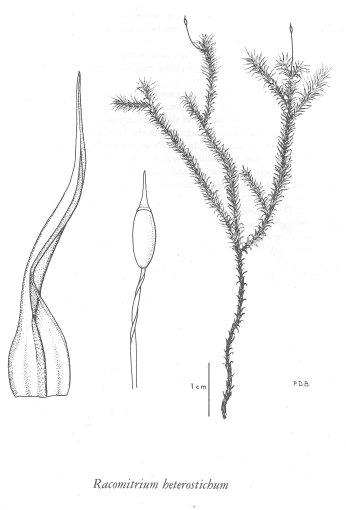Racomitrium heterostichum (Hedw.) Brid.
yellow-green rock-moss (racomitrium moss)
Grimmiaceae
Species Account Author: Wilf Schofield
Extracted from Some Common Mosses of BC
Introduction to the Bryophytes of BC
yellow-green rock-moss (racomitrium moss)
Grimmiaceae
Species Account Author: Wilf Schofield
Extracted from Some Common Mosses of BC
Introduction to the Bryophytes of BC
Map
Distribution of Racomitrium heterostichum
Click here to view the full interactive map and legend
Species Information
Species description:
Species name referring to the somewhat one-sided arrangement of the leaves in some specimens.
Reproduction:
Sporophytes common, reddish-brown to pale brown when mature; maturing in spring.
Distinguishing characteristics:
This is the most variable of the species of Racomitrium in the province and is not easy to distinguish on hand-lens characters. Regrettably it shows considerable variation in growth form as well. Plants are never yellow-green, usually possess white hair points, and are usually firmly affixed to rock surfaces in dry sites, thus compressed tufts of irregularly branched plants are the rule.
Habit:
Forming mats of reclining to suberect shoots strongly affixed to the substratum or loosely affixed in older plants. Plants dark green to brownish-green to nearly whitish-green when hair points are long; irregularly to regularly branched.
Similar Species:
As treated here, R. heterostichum includes a number of related species that are difficult to separate on hand-lens characters. In British Columbia the following species belong to this complex group: R. affine, R. microcarpon, R. obesum and R. occidentale, as well as R. heterostichum. Species of Grimmia with white hair points (e.g., G. pulvinata) and Coscinodon calyptratus can superficially resemble R. heterostichum. The Grimmia has curved setae, however; the Coscinodon has large sheathing calyptrae that differ from the small calyptrae of Racomitrium. Microscopic features (especially the sinuose walls of cells of Racomitrium) quickly separate this genus. Hedwigia ciliata lacks a midrib in the leaf and is usually whitish to yellow-green (see notes under Hedwigia). See also notes under R. lanuginosum and R. canescens. R. varium is difficult to distinguish on hand-lens characters. Dryptodon patens has two ridges on the back of the costa which are lacking in Racomitrium. See also R. sudeticum.
Illustration

If more than one illustration is available for a species (e.g., separate illustrations were provided for two subspecies) then links to the separate images will be provided below. Note that individual subspecies or varietal illustrations are not always available.
Illustration Source: Some Common Mosses of BC
Habitat and Range
Habitat
Exposed rock surfaces of outcrops and boulder slopes, from sea level to alpine elevations. Range
World DistributionWidespread in temperate portions of the Northern Hemisphere; in North America southward to the southern Appalachian Mountains and westward to the Great Lakes states and northward across the continent to Alaska, in the west southward to California and eastward in the Rocky Mountains of Colorado.
Status Information
Synonyms
Synonyms and Alternate Names:
Racomitrium heterostichum var. gracilescens Bruch & Schimp.
Racomitrium heterostichum var. heterostichum
Racomitrium heterostichum var. microcarpon (Hedw.) Boul.
Racomitrium heterostichum var. ramulosum (Lindb.) Corb.
Racomitrium ramulosum Lindb.
Rhacomitrium heterostichum (Hedw.) Brid.